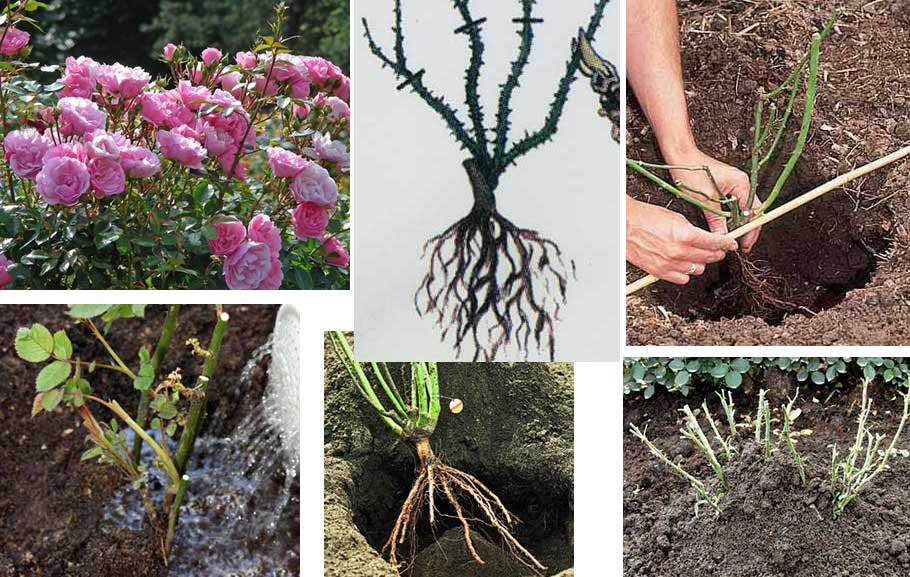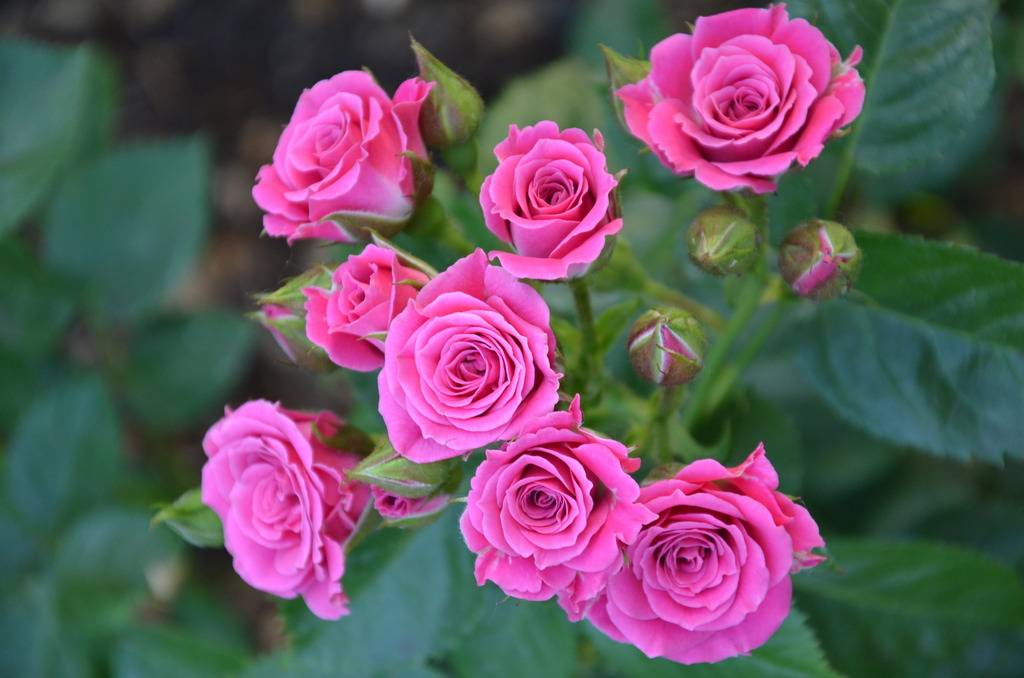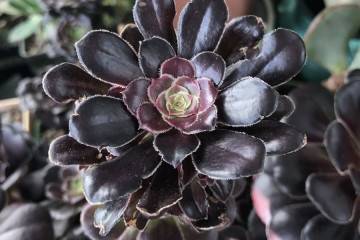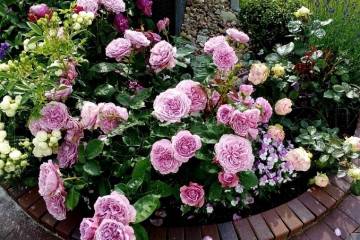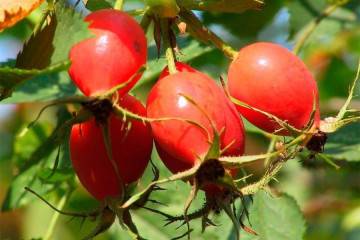Rose Lydia Lovely - what is this flower of the floribunda family
Content:
Rose is the personification of earthly joys and sensual pleasure. It was and is. Spray, or patio, the Lydia rose belongs to the floribunda (abundant flowering) group. The variety was bred in the Netherlands by breeders of the Interplant company in 1995. It is called a bush rose with inflorescences. The variety immediately won the recognition of florists.
Brief description and characteristics
Spray rose Lydia (Latin Lydia) has the following characteristics:
- compact bushes, 50-60 cm high, erect, densely leafy, without thorns;
- leaves are dark green, oval;
- flower color from pale pink to juicy crimson;
- goblet flowers are collected in inflorescences, in one up to 10 buds. Each such brush is already a wonderful bouquet;
- flower diameter up to 4 cm;
- long flowering, from early June to September.
Advantages and disadvantages
Pros of the variety:
- appreciated for its continuous flowering, abundant and long-lasting;
- bunches of flowers are very effective;
- erect bush. No thorns;
- unpretentious care;
- frost resistance up to -23 ° C;
- love rose Lydia has good immunity.
There is only one drawback - a weak aroma.
Use in landscape design
In garden design, this low spray rose looks gorgeous in group plantings, in beddings. Shrub rose Lovely Lydia rightfully occupies a place in the foreground of the flower garden, it is especially good against the background of conifers. It is used as a curb along the paths, and in tall flowerpots it is simply irresistible. Fits perfectly into the alpine slide.
Growing a flower: how to plant it in open ground
The plant is very decorative and unpretentious. Flower petals do not fade in the sun and do not fade from rain.
In Russia, classic roses Lydia, Lovely Lydia are propagated by cuttings. Of these, seedlings are grown throughout the year.
The most favorable time for planting seedlings is spring.
Seat selection
The most favorable place for the Lydia variety is open, sunny places. It also tolerates partial shade.
How to prepare the soil and flower for planting
Prepare a site for planting rose bushes in advance. Work can begin a month before.
The main stages of preparing a landing site:
- clearing the site from weeds;
- deep digging to the height of the humus layer;
- preparation of holes for planting;
- preparation of a nutrient substrate for laying in pits.
Basic recommendations for preparing a seedling for planting:
- before planting, the seedling is trimmed, the stems with mechanical damage, dry branches are removed;
- shortening the root system by 1-1.5 cm;
- soaking the roots in a solution of biostimulants.
Planting procedure step by step
Patio roses, which Lovely Lydia belongs to, are not picky, although they love black soil.
Planting stages:
- Before planting, the pit is filled with a prepared nutrient mixture consisting of turf, peat, sand and mineral fertilizers.
- The seedling is covered with soil strictly along the root collar.
- Watering is carried out immediately. You need at least 10 liters per bush.
Plant care
An adult bush is undemanding and not capricious, but the Lovely Lydia rose variety cannot be ignored. Timely watering is required, followed by loosening of the topsoil to improve aeration. Top dressing is applied in spring and summer. Also important is the sanitary cleaning of the bushes and the removal of faded buds.
Top dressing and soil quality
Roses are considered one of the most responsive and grateful plants for fertilization and watering. Bushes need different nutrients at different times of growth.
In the spring, it is necessary to replenish the lack of nitrogen for the developing vegetative mass. In summer, development requires the use of a complex fertilizer with a full set of micro- and macroelements. In autumn, phosphorus and potassium are needed for better ripening of the shoots.
Pruning and replanting
The ratio between the aboveground and underground parts of the plant is regulated by pruning. But you need to trim correctly and in a timely manner.
Long-term flowering is not easy. If the pruning is done weak, then flowering will come early, and the growths will be thin and elongated. Roses of this group bloom on the shoots of the current year. Therefore, the abundance of flowering depends on pruning.
When planting floribunda roses in spring, a strong (short) pruning is used. This helps to obtain long and strong stems for cutting. However, combined pruning is more commonly used:
- weak pruning for early flowering and strong for later;
- a slight shortening is carried out in the fall;
- strong shoots on old branches are cut into a ring or up to 5 buds are left. This technique opens the center of the bush.
Features of wintering a bush
Covering variety. They are not transplanted for the winter, they are left in the ground.
Preparation for wintering begins in the fall:
- stop watering;
- stop cutting flowers.
Before the onset of the first frost, the bushes need to be covered with earth or peat to a height of up to 20 cm.
In October, it is recommended to carry out sanitary pruning, after which all remaining healthy shoots should be shortened to 30-40 cm. At the first freezing of the soil, the roses are completely covered.
Blooming rose
The rose is one of the first to bloom and blooms until late autumn. Up to 10 buds on one branch. Flowers 4-5 cm in diameter. The color range of the buds ranges from light tones to deep pink.
A period of activity and rest
Without fail, during the entire growing season, fertilizing, watering, loosening and removing weeds are needed.
Care during and after flowering
Nitrogen fertilizing should be excluded. Watering is carried out as needed, as well as loosening, removal of wild growth.
During flowering, faded buds are cut off.
What to do if it does not bloom
The plant is weakened after winter or frozen. You need to feed, slightly shorten the branches and give the bush time to recover.
Flower propagation
Currently, a large selection of planting material is offered. It is very interesting to reproduce a flower on your own. Basically, the rose bush Lydia propagates by cuttings and dividing the bush.
Cuttings are carried out from late June to late July. Prepared cuttings are planted in a greenhouse for rooting. They are transferred to open ground in the spring of next year, and only in the fall are seedlings planted in a permanent place.
Cuttings soaked in a growth stimulator are planted in a prepared greenhouse no deeper than 1.5-2 cm, leaving a distance of 5 cm between the cuttings and 10-12 cm in row spacing. Cover with a film, having previously sprayed with clean water.
Further care consists in airing, spraying, loosening the soil and shading as needed.
2-3 weeks later, callus is formed, the same amount will go into the growth of the buds, roots will appear.
Diseases, pests and ways to control them
No matter what they say, but there are no absolutely resistant roses to diseases and pests. Despite the average resistance of Lydia's spray rose, infectious diseases such as:
- gray rot;
- powdery mildew;
- black spot;
- viral mosaic.
Lovely Lydia's curb rose, improperly planted and therefore weakened, can suffer from disease. Pathogens (bacteria, viruses) actively multiply in shady, thickened places. To prevent the development of infectious diseases, preventive spraying with iron sulfate or systemic fungicides is carried out.
Pests can also annoy: spider mites, rose aphids, golden bronze. In case of severe pest damage, they are treated with aktar or aktelik. If there are few beetles and caterpillars, they are harvested by hand, preferably in the early morning.
A description of the Lovely Lidia variety and advice on reproduction and care will help you choose and grow this particular wonderful variety. Do not be afraid to create beauty, it is very exciting!

